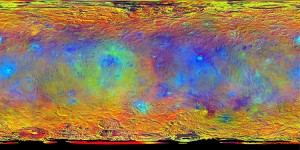Ceres Probe Returns Harvest of Data, But Mysteries Remain
October 5, 2015

This map-projected view of Ceres was made from images taken by NASA’s Dawn spacecraft during its high-altitude mapping orbit in August and September of 2015.
Credit: NASA/JPL-Caltech/UCLA/MPS/DLR/IDA
Those bright spots are still a bit mysterious. Last week, the United States National Aeronautics and Space Administration (NASA) released more data from the dwarf planet Ceres (SIHR eez) taken by the probe Dawn. These data included more pictures and three-dimensional maps of Ceres’ surface.
In addition to being a dwarf planet, Ceres is the largest of the many asteroids found between the orbits of Mars and Jupiter, in a region known as the Main Belt. Ceres accounts for more than one-fourth of the total mass (amount of matter) of the Main Belt asteroids. Ceres’ shape resembles a slightly squashed sphere with a widest diameter of 605 miles (975 kilometers) and a shortest diameter of 565 miles (909 kilometers). It has a fairly smooth, rocky surface and little or no atmosphere. The dwarf planet orbits the sun every 4.6 Earth years at an average distance of about 257 million miles (414 million kilometers), and it takes its name from the Roman goddess of agriculture and the harvest.
NASA launched Dawn on September 27, 2007, just over 8 years ago. The probe studied another large asteroid in the Main Belt called Vesta before moving on to Ceres. Dawn has gone into orbit around the dwarf planet and has extensively mapped and photographed the surface. Although Ceres is pockmarked with craters like many small objects in the solar system, it does possess some interesting features. Scientists think that its rocky exterior covers a thick layer of water-ice. Though the asteroid is relatively smooth, a large, cone-shaped mountain rises four miles (six kilometers) from the surface.
And finally, there are those strange bright spots. Mostly located in the Occator (oh KAH tor) crater, these spots are far brighter than the rest of Ceres’ surface. Scientists think the spots are salt deposits, but they aren’t yet sure how they formed. In the coming months, Dawn will descend to just 230 miles (375 kilometers) above the dwarf planet. With the information gathered by this close orbit, the probe may be able to help scientists solve Ceres’ riddles.
Other World Book articles
- Exploring the Suburban Solar System (a Special report)
- Closing in on Ceres (a Behind the headline, January 21, 2015)


